 |
|
If "global warming" is real, what could be causing it?
JunkScience.com
June, 2006
In response to apparent confusion regarding the Earth's greenhouse effect we recently released the real "Inconvenient Truth": greenhouse, global warming - and some facts, and this document assumes the reader to be comfortable with at least a rudimentary understanding of the topic. In order to evaluate claims of global warming and enhanced greenhouse we need to examine estimates of global temperature and trends. As we gain an idea of the change involved we can attempt to quantify what portion of that change may be driven by other changes in the system. Did human activity cause all, part or none of the observed change? Let's see what we can work out:
Contemporary estimates of Earth's recent temperature history
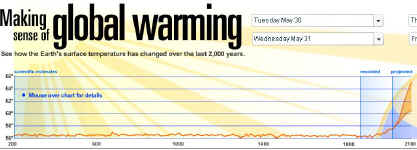 Topical in the news at present is USA Today's feature series, apparently meant to accompany Al Gore's movie and book circus, so we
might as well start there. The adjacent thumbnail links to a screen capture of their interactive global temperature history and projection. The capture was made
from this piece. We'll revisit this in a moment.
Topical in the news at present is USA Today's feature series, apparently meant to accompany Al Gore's movie and book circus, so we
might as well start there. The adjacent thumbnail links to a screen capture of their interactive global temperature history and projection. The capture was made
from this piece. We'll revisit this in a moment.
The National Academies convened a committee this year for the project Surface Temperature Reconstructions for the Past 2,000 Years: Synthesis of Current Understanding and Challenges for the Future with the express purpose of trying to sort out what we do and can know of past temperatures. From reports of observers present when paleoclimatologists presented to the committee, we know that presenters were asked if they could reconstruct temperatures from a thousand years ago to within 0.5 °C (0.9 °F). All apparently denied such ability with the exception of Mike "Hockey Stick" Mann, who claimed a precision of 0.2 °C (0.36 °F). Those of us who spend much time fossicking amongst raw data looking for clues to past temperatures tend to greet such claims with an indulgent smile and something like: "Sure Mikey, sure..." but that's his claim.
Returning to USA Today's interactive graphic, they present a near flat line representation of some 16 centuries, supposedly accurate to one ten-thousandth of a degree Fahrenheit. While Mann's claim of ±0.36 °F precision elicits polite disbelief the depiction by USA Today causes the forcible suppression of Gore debating-style sighs. Nonetheless, this depiction is now widely proliferated in the public domain and emphatically depicts Earth's temperature as stable until about 1850, following which all estimated warming occurred.
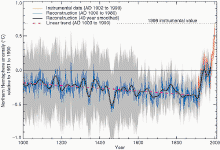 Another widely disseminated depiction,
having featured in the IPCC's Third Assessment Report (TAR), is Mike's Magic Hockey Stick,
linked from the thumbnail graphic at right. This, too, depicts all warming as subsequent to 1850. This feature will be significant as we begin attempting to
apportion possible causation later.
Another widely disseminated depiction,
having featured in the IPCC's Third Assessment Report (TAR), is Mike's Magic Hockey Stick,
linked from the thumbnail graphic at right. This, too, depicts all warming as subsequent to 1850. This feature will be significant as we begin attempting to
apportion possible causation later.
By now readers will be aware we are more than a little sceptical of claims of great precision reconstructing past temperatures, so perhaps we should take a moment to point out how imprecise are estimates even of current global mean temperature. Of surprise to most people is that we don't even have an agreement on what we mean by absolute mean surface temperature. In addition to this lack of standardization is that there is a general paucity of data. This may seem strange to people used to electronic media reports constantly telling us the temperature but, in truth, very little of the globe is regularly sampled for near-surface air temperature and such sampling is subject to local influences which change over time (see Lawrence Berkeley National Laboratory's Learning About Urban Heat Islands pages for more on this). Near-surface measures are fraught with difficulties, not least is variation in sampling and drift over time in sampling location - see Microclimate Exposures Of Surface-Based Weather Stations: Implications For The Assessment of Long-Term Temperature Trends (.pdf) - "New photographic metadata of eastern Colorado stations are examined, raising questions about the usefulness of current surface datasets for climate applications." (Christopher A. Davey and Roger A. Pielke Sr., BAMS) The late John L. Daly explored this problem in a report to the Greening Earth Society "The Surface Record: ‘Global Mean Temperature’ and how it is determined at surface level" which will tell you a lot more about the trials and tribulations of establishing temperatures.
With such difficulties determining temperature and trends, are we convinced the planet is warming?
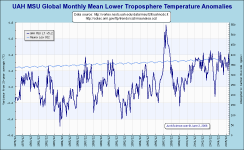 The answer is yes, at least recently. Since the late-1970s satellite-mounted microwave sounding units (MSUs) have provided data allowing the
determination of tropospheric temperatures and from this we are aware that there has been at least some warming over the period. While it is apparent that much
of the trend is a result of the large El Niño-induced spike of 1998 there is, however, reduced oscillation and some warming evident since 2000.
The answer is yes, at least recently. Since the late-1970s satellite-mounted microwave sounding units (MSUs) have provided data allowing the
determination of tropospheric temperatures and from this we are aware that there has been at least some warming over the period. While it is apparent that much
of the trend is a result of the large El Niño-induced spike of 1998 there is, however, reduced oscillation and some warming evident since 2000.
So, just about everyone can agree there has been some warming, at least recently. This begs the questions of "How much?" and "Compared to when?". As we have seen above, according to the IPCC's TAR and America's picture paper, all warming has occurred since the Industrial Revolution. This belief has led to post hoc, ergo propter hoc claims of IR-driven warming (atmospheric carbon dioxide levels are known to rise, the planet is believed to warm, therefore atmospheric carbon dioxide warms the planet).
Is there any reason to doubt the stable temperature, sudden warming scenario?
 Actually
there are lots of reasons, ranging from historical accounts and literature to competing paleotemperature studies, a number of which are plotted for you here.
Actually
there are lots of reasons, ranging from historical accounts and literature to competing paleotemperature studies, a number of which are plotted for you here.
The adjacent graphic is from the decade-old (and pre-PC) The Little Ice Age and Medieval Warm Period in the Sargasso Sea - "Sea surface temperature (SST), salinity, and flux of terrigenous material oscillated on millennial time scales in the Pleistocene North Atlantic, but there are few records of Holocene variability. Because of high rates of sediment accumulation, Holocene oscillations are well documented in the northern Sargasso Sea. Results from a radiocarbon-dated box core show that SST was ~1 °C cooler than today ~400 years ago (the Little Ice Age) and 1700 years ago, and ~1 °C warmer than today 1000 years ago (the Medieval Warm Period). Thus, at least some of the warming since the Little Ice Age appears to be part of a natural oscillation." (Lloyd D. Keigwin, Science, 274: 1503-1508)
The Center for the Study of Carbon Dioxide and Global Change is currently engaged in their Medieval Warm Period Project, documenting "the magnitude and spatial and temporal extent of a significant period of warmth that occurred approximately one thousand years ago. Its goal is to ultimately provide sufficient real-world evidence to convince most rational people that the Medieval Warm Period was: (1) global in extent, (2) at least as warm as, but likely even warmer than, the Current Warm Period, and (3) of a duration significantly longer than that of the Current Warm Period to date."
We happen to find historical accounts and proxies indicating climatic variation rather more compelling than assertions of millennia-long climate stasis. Nonetheless we will work with such scenarios as we attempt some quantification of the drivers of global temperature change. Regarding contemporary global mean temperature change, is it plausible, even likely, there has been a change of around a half-degree Centigrade since the Industrial Revolution? The short answer is "Yes". The long answer is "Yes, certainly. There is nothing apparently unusual nor alarming about small shifts in global mean temperature. We are only talking about 0.2% change in Earth's mean temperature of 288 K and we are pretty sure increased solar irradiance accounts for a goodly portion of that change."
Is carbon dioxide the culprit?
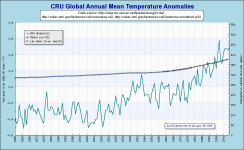 There has been an extraordinary amount written and said regarding the correlation between increasing atmospheric carbon dioxide levels since
the Industrial Revolution and an apparent warming trend in global mean temperature. From the vehemence with which this is asserted one would assume the
temperature/atmospheric carbon dioxide plot to be absolutely compelling. As can be seen in the graphic linked from the adjacent thumbnail, such assumption is
poorly founded.
There has been an extraordinary amount written and said regarding the correlation between increasing atmospheric carbon dioxide levels since
the Industrial Revolution and an apparent warming trend in global mean temperature. From the vehemence with which this is asserted one would assume the
temperature/atmospheric carbon dioxide plot to be absolutely compelling. As can be seen in the graphic linked from the adjacent thumbnail, such assumption is
poorly founded.
Carbon dioxide is a greenhouse gas, something which can be experimentally demonstrated in the lab, so it is intuitively reasonable to assume that rising levels of this greenhouse gas will have some effect -- but how much?
Professor Roger Pielke, Sr., suggests a figure of 26.5%-28% of contemporary warming is attributable
to atmospheric carbon dioxide, so, of the IPCC's estimated
What about the sun?
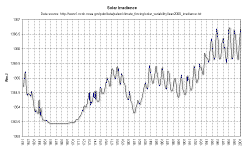 This
Solar Irradiance Reconstruction is by Judith
Lean, Naval Research Laboratory. ABSTRACT (Lean 2000): Because of the dependence of the Sun's irradiance on solar activity, reductions from contemporary levels
are expected during the seventeenth century Maunder Minimum. New reconstructions of spectral irradiance are developed since 1600 with absolute scales traceable
to space-based observations. The long-term variations track the envelope of group sunspot numbers and have amplitudes consistent with the range of Ca II
brightness in Sun-like stars. Estimated increases since 1675 are 0.7%, 0.2% and 0.07% in broad ultraviolet, visible/near infrared and infrared spectral bands,
with a total irradiance increase of 0.2%.
This
Solar Irradiance Reconstruction is by Judith
Lean, Naval Research Laboratory. ABSTRACT (Lean 2000): Because of the dependence of the Sun's irradiance on solar activity, reductions from contemporary levels
are expected during the seventeenth century Maunder Minimum. New reconstructions of spectral irradiance are developed since 1600 with absolute scales traceable
to space-based observations. The long-term variations track the envelope of group sunspot numbers and have amplitudes consistent with the range of Ca II
brightness in Sun-like stars. Estimated increases since 1675 are 0.7%, 0.2% and 0.07% in broad ultraviolet, visible/near infrared and infrared spectral bands,
with a total irradiance increase of 0.2%.
Back of an envelope calculation: Earth is estimated to have warmed
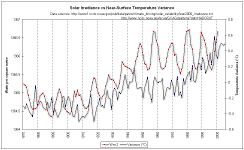 Let's look at this a little more carefully. Assuming all warming has taken place since the mid-Nineteenth Century, (an assertion
with which we do not concur), solar influence could still account for the bulk of assumed change because the difference in solar irradiance from the
(admittedly cherry-picked) low of 1889 to end of available record is 2.33 Wm-2 or 0.17% and Earth's temperature of 288 K + 0.17% = 288.49 K, a figure
well within our warming bounds of 288
Let's look at this a little more carefully. Assuming all warming has taken place since the mid-Nineteenth Century, (an assertion
with which we do not concur), solar influence could still account for the bulk of assumed change because the difference in solar irradiance from the
(admittedly cherry-picked) low of 1889 to end of available record is 2.33 Wm-2 or 0.17% and Earth's temperature of 288 K + 0.17% = 288.49 K, a figure
well within our warming bounds of 288
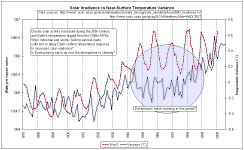 Much has
been made of sulphate aerosols "masking" warming that would otherwise have occurred and so we might ponder whether the post-WWII boom of
reconstruction and development added significantly to atmospheric aerosols. This could have induced the apparent lag in solar warming in the 1950s and
1960s. Additionally, this was the Cold War era of atomic weapons development and atmospheric testing which could have added to atmospheric particulate
load (remember the fears of "nuclear winter"?). Unfortunately, we lack the resources to check this at present but we may revisit the hypothesis in the
future. Further research is required, as they say.
Much has
been made of sulphate aerosols "masking" warming that would otherwise have occurred and so we might ponder whether the post-WWII boom of
reconstruction and development added significantly to atmospheric aerosols. This could have induced the apparent lag in solar warming in the 1950s and
1960s. Additionally, this was the Cold War era of atomic weapons development and atmospheric testing which could have added to atmospheric particulate
load (remember the fears of "nuclear winter"?). Unfortunately, we lack the resources to check this at present but we may revisit the hypothesis in the
future. Further research is required, as they say.
So, while the solar irradiance/temperature variance fit is not entirely compelling it is a significant improvement over that of temperature/atmospheric carbon dioxide.
There are, of course, other potential anthropogenic influences on global mean temperature, although the net sign remains unknown of such changes as albedo (Earth's reflectivity) resulting from land use change, humidity and cloudiness in response to plant transpiration changes from broad scale agriculture and irrigation. Then there's changing particulate loads and aircraft exhaust affecting cloud abundance, altitude and type, etc., to name but a few. It could be that these other anthropogenic effects tend to cancel each other out, leaving a net total change of zero, we just do not yet know enough to quantify everything.
Always assuming the estimated warming of +
Where does that leave us?
On the matter of Earth's recent climate history, it is implausible that despite variance in solar irradiance Earth has had a stable temperature for the last 1,000-2,000 years. History instructs us this is not so, literature tells us this is not so, and a large spectrum of paleotemperature reconstructions tell us this is not so. USA Today and the hokey "Hockey Stick" representations are obviously wrong, regardless of how politically correct their concept of human culpability might be.
Regarding whether Earth has really warmed to some extent, regardless of our ability to accurately determine it? Yep, we have no problem with that. We have seen nothing compelling regarding Earth's current suspected temperature trend being anything extraordinary nor alarming but we have no reason to believe Earth's mean temperature is not changing, or that it does not do so continuously -- frankly, temperature stasis is a myth.
Does increasing carbon dioxide affect Earth's mean temperature? Yes, although probably only trivially and to a declining extent. Note that Professor Pielke, Sr., is firmly in the camp of believers in anthropogenic global warming but freely admits carbon dioxide to be a less-than-critical factor necessitating obsession and, despite somewhat bizarre claims of Professor Lindzen being a "hired gun" and paid-for shill of an alleged "Big Oil" conspiracy, he is a senior and well-respected pure scientist who gleefully admits carbon dioxide's role in enhanced greenhouse, although he does point this out to be trivial and does not subscribe to the planetary emergency scenario. Pielke and Lindzen are no orphans since most so-called "skeptics" similarly point to anthropogenic climate influence as interesting effects to be understood without necessitating hand-wringing and hair shirts.
Increased solar activity? Absolutely and at least half of Earth's estimated mean temperature increment since the Nineteenth Century can be attributed to increased solar irradiance, probably more than four-fifths is from that source although we are still trying to sort out climate and forcings, something which will likely require decades yet. Nonetheless, the best available thermometric temperature records list Earth's global mean temperature as variance from a commencing benchmark average, usually 1951-1980 or 1961-90, and show -0.3 °C c1880 or 1870, with 0.0 °C variance from this average occurring c1940 and with 2000 listed as +0.3 °C. In other words, Earth warmed 0.3 °C from origin of record to benchmark average by 1940, then warmed another 0.3 °C subsequently. Since the vast majority of the carbon dioxide increase in the atmosphere occurred following the Second World War and this is concurrent with only half the apparent temperature increase, the assumption is that this increase was driven by some other cause, in this case the increase in solar irradiance. There is no reason to believe all other temperature varying forces ceased to exist when carbon dioxide began accumulating, hence the "at least half" attribution above.
Are we looking at a looming disaster from carbon dioxide emissions? There is absolutely zero indication of that. Although human emission of carbon dioxide has likely had some measurable effect on planetary temperature the effect from continued emission is rapidly diminishing as radiative windows in which carbon dioxide is active approach saturation. Before long carbon dioxide emission will have exactly no discernable effect on global temperature.
Can we have significant effect on global temperature trend by limiting future carbon dioxide emission? No -- no equivocation and no argument entertained, allusion to "control" of the planetary thermostat by tweaking minor parameters is a nonsense.
Do we face a planetary emergency precipitated by carbon dioxide emissions? No, there is zero evidence that such a scenario might be true.
Are we personally troubled by carbon dioxide emissions? No.
Do we believe a warmer world would be worse than a cooler world? No, quite the reverse since a cooler world would make feeding the current population significantly more difficult, far more so the anticipated increasing population of the next generation or so. If there is to be a change in global mean temperature then warmer is distinctly preferable to cooler.
Frankly USA Today have made a nonsense of "global warming" and we don't know what planet Ozone Al is on but he apparently has no idea about this one or its climate. As always, we need to adapt and protect ourselves from the natural environment and that will take more than shouting to frighten away the thunder, as our distant ancestors apparently did. Fortunately we are continuing to master our built environment while increasing productivity to leave more room and resources for wildlife and wild habitat, something only increased productivity can do in the face of increasing human population. Of course, increasing productivity relies both on abundant, affordable energy and abundant carbon dioxide. There are no apparent looming shortages of either, provided we don't do anything stupid. Suddenly affecting lemming-like qualities and following Ozone Al's teachings like a bunch of blind Patagonian Sheep would qualify as something really stupid.
You're not likely to do that, are you?
Copyright © 2006 JunkScience.com - All Rights Reserved